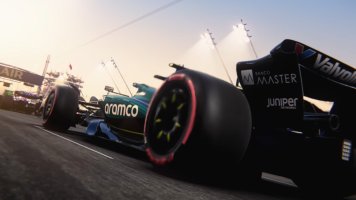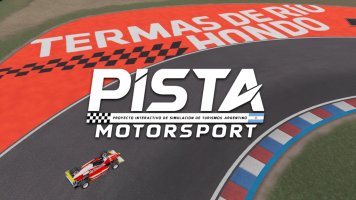I think they intended it as a supplement for the direct-to-the-point technologies (motion and gforce). For that it is probably fine. More than fine. But alone, even if you can make the tactile better by spending thousands and getting really deep, just isn’t the ideal way to go.
Again, it’s a terrific supplement.
I think the video clarifies something with many Sim-based YT channels or reviewers on those channels. Some have rather limited experiences with tactile, well perhaps not to the level quite a few people here or in other places already have or own.
So its harder for them to compare against or form a base of what okay or really good tactile is or how it differs in the immersion, fun, entertainment or experiences it adds.
Mike (nice guy) was still quite impressed by the addition of immersion and new life the tactile added. Let's not overlook that before we challenge what we have seen.
You only have to read some of the comments in the video to see how this actually also impresses some people. I get the impression, that some may see 4 units and 4 springs and be like wow!!! It looks quite exciting/different but is it likely some may take it for granted, this will offer a limited suspension/motion experience from the tactile.
We commonly see budget tactile owners/users repeatedly using frequencies between 30Hz-80Hz for many effects. This will be no different. Yet, often a user's own preferred or fave effects, they may use something @ 40-60Hz as this is within the peak output for many models of budget transducers.
When you begin to use the same frequencies over and over this has its own drawbacks regards the generated amplitude of those frequencies but basically, it will make it even harder to feel anything but those peak frequencies the unit delivers best and the user keeps repeating.
What you get in doing this, is a rather narrow frequency range, that feels okay in the scenario of different effects only active briefly, but has a tendency that makes many effects feel very much the same with it being hard to distinguish one effect from another. This is especially the situation when multiple effects are active and that is a typical problem with standard tactile approaches. Any unit will reach a limit with the number of sensations you try to have it manage.
The only way beyond this is simply explained.
To expand your usable frequency range in what frequencies your effects can use or have output. Then to add more body regions. So with this, you have both a wider variety of how sensations are going to feel but also where and how these are felt/detected over your body regions.
Therefore, no longer restricted to a limited frequency range and having all effects being felt/generated and coming from the same fixed position.
So like any 4-way type installation. This configuration has limitations, those effects are always limited to only 2 units to represent what you will primarily feel in the seat and pedals. Yes, some effects for the seat may be felt in the pedals and vice versa, but with simulation, you don't always want that either.
Why, well because with tactile, what matters is having more control to determine by design or concept within your effects, what or how sensations are generated for each body region, and what the combined results in applying that can achieve. Having control is better than not being able to control what is felt.
Here is the first challenge with this system, as its performance is already determined to be at the entry-level with the Aura Pro used. These are very similar in performance to Reckhorn units. Fair enough as Mike points out it offers a new experience over a single BK as yes it is multichannel based.
My own views:
Here are the things I would say are potentially wrong with what this tries to do.
First is, it may give a false impression as to what it really can offer in immersion. The springs make it look exciting, yet their main role is nothing to do with suspension/motion but to help maintain the vibes within the rig frame.
Q. Why would the design not just attach springs to the main frame at the corners of the rig. This way the actual tactile unit is not directly in contact with the spring itself.
The design used, appears to enable the peak output from the unit to be channeled directly into the floor.
However yes the plate also makes direct contact with the rig frame itself too, but surely people can query that it offers a route/pathway for the units generated output to be restricted/reduced well before it reaches its target/destination area.
Two very important things to remember with tactile...
1. Ask yourself, where will the user feel the vibrations? This is easy to answer as it's the body regions we have that are in contact with the rig or components connected to the rig which contain the actual vibrations.
(Primary = Seat/Pedals)
(Secondary = Wheel/Shifter)
2. Look at where the tactile is installed, ask yourself what pathways it have to take to reach its intended destination. Take into account what other possible pathways the vibrations can travel. This will be with any other surfaces, objects that are in contact with the primary installation surface and in contact with each other.
I would say based on my own experiences, that better performance from the units could be achieved if the full peak energy of the tactile units was not wasted but instead was better channeled directly into the materials supporting the primary/secondary components that our body regions have contact with?
Does it not make sense that the seat/pedal sections are not only smaller in comparison to the whole rig frame and if we have these as plates/sections isolated independently from the rig frame. It will then deliver more of the primary energy and detail into the user's body more efficiently.
Folks, simply because it is more directly installed to the user's body regions and less of the energy/detail will disperse to other pathways or directly into the floor prior to you feeling its output.
We should aim to maximise the output of the unit with closer installation placement to the body regions.
To not aim to have, fake wheel/suspension or the whole rig lit as tactile active. As it is much bigger and has increased distance for the tactile to travel. Also as mentioned, producing multiple pathways or contact objects/surfaces the vibrations can and will travel through. This, therefore offers reduced felt sensations, less detailing, and brings limited control.
It is, of course, possible to isolate seat/pedals as recommended instead of the whole rig frame but then have, additional, secondary isolation for the rig frame if desired. This could be spring-based solutions, dampening rubber pads, or industrial rubber wheels. Just depends on how important it is for the user to reduce the number of vibrations that go into the floor.
Regardless of what is used, you cannot fully control the flow, and this becomes more of a challenge if you have much more powerful units as well as units more capable with harmonics or introduce full range game audio into the tactile.
I would say this solution is a bit odd as it does not in my view, make the most of what the tactile will be delivering. Also that should be the priority. It might even be questionable based on how/where the springs are installed, how much the springs add to improve the immersion the units deliver.
Not wanting to come off as being harsh, but this is basically a 10-year-old entry-level Simvibe CM-based installation on springs that appears to use very basic and limited effects within Simhub.
Issues with 4 Corners
It would also likely only offer rather limited stereo representation with L/R-based effects. As it's easy for tactile vibrations from the L/R to mix within a very narrow sim rig cockpit.
Additionally, with the tactile having multiple pathways to travel L/R and F/B freely in my view it is limited in what control of the tactile dispersion it offers, but this is a common issue with 4 way installations.











